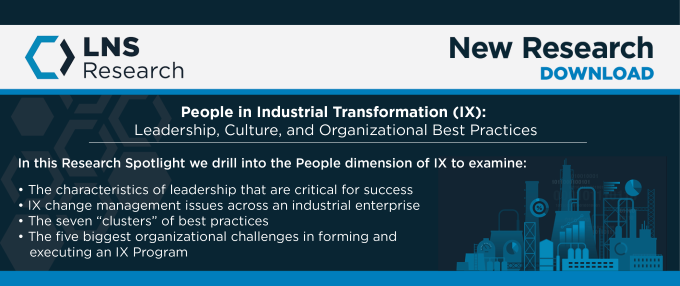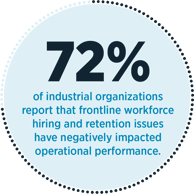 Manufacturers have long been struggling to meet workforce expectations and build future-proof operations. Seventy-two percent of industrial organizations report negative impacts on operational performance due to “The Great Goodbye” being seen across frontline operations.
Manufacturers have long been struggling to meet workforce expectations and build future-proof operations. Seventy-two percent of industrial organizations report negative impacts on operational performance due to “The Great Goodbye” being seen across frontline operations.
This blog will provide Global Operations Vice Presidents with best practices to attract, train, and retain employees and future-proof the frontline.
Future of Industrial Work for Future-proof Operations
LNS Research defines Future of Industrial Work (FOIW) as a proactive, comprehensive, and lifecycle-based approach to building an empowered future-ready frontline workforce. A global survey in late 2022 identified workforce strategy, practices, and capabilities of industrial organizations deployed across people, process, and technology. FOIW expands our popular Connected Frontline Workforce research to a more holistic transformation framework that redefines and improves the nature of industrial work.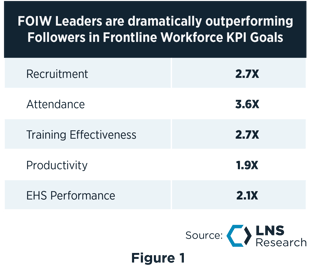
FOIW Leaders, the top 19% of companies achieving real success and delivering corporate value through workforce initiatives, provide proven best practices that increase operational performance. In addition to seeing ~10% better, on average, operational performance, Figure 1 shows FOIW Leaders are two times more likely to exceed frontline workforce key performance indicators (KPIs) to outperform Followers dramatically.
Research shows three strategic imperatives to future-proof frontlines and operations:
-
-
-
Reimagine the employee lifecycle to support and serve the frontlines.
-
Meet employees where they are. Prioritize leadership and culture of
the frontlines.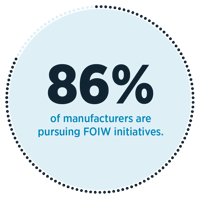
-
Deploy human-centric technology designed for and used by the frontlines.
Eighty-six percent of manufacturers have implemented, are currently implementing, or plan to implement workforce initiatives as workforce issues continue to intensify. Let’s examine how FOIW Leaders adapt and transform frontline operations to win the war for talent.
Building a Sustainable Workforce Strategy
The current environment includes rapidly changing workforce demographics and a diminishing labor market that continues to shift the balance of power toward employees. This section introduces the LNS Research Future of Industrial Work Framework (Figure 2) and provides best practices for the three strategic imperatives to attract and retain a quality workforce.
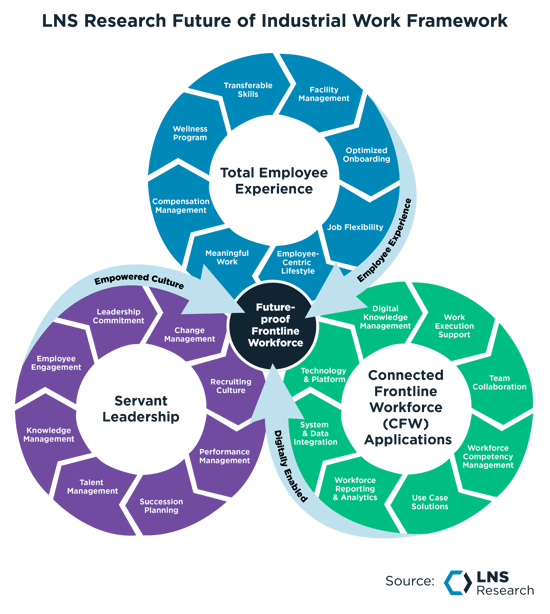
Figure 2
Total Employee Experience
FOIW Leaders recognize that existing practices have long been unable to meet the needs of manufacturers and are shifting to an employee-centric lifecycle. To better meet next-gen workforce expectations, the reimagined lifecycle prioritizes the total employee experience and how a person perceives their employment experience. To better visualize this concept, we compare the lifecycles in Figure 3 below.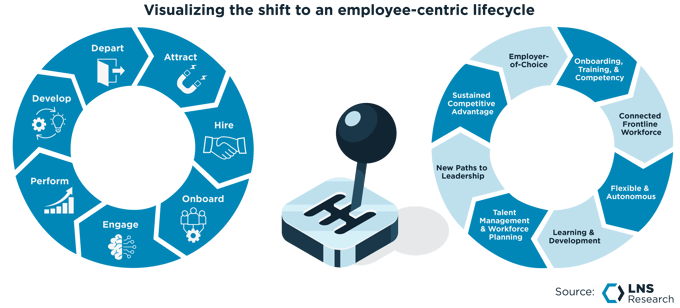
Figure 3
LNS Research studies have found that the business objectives of FOIW Leaders are almost two times more likely to seek the status of “Employer of Choice®,” a company recognized for leadership, culture, and best practices that attract, optimize, and hold top talent. Compared to FOIW Followers, Leaders are three times more likely to fund initiatives that enable an employee-centric lifecycle.
Total Employee Experience efforts FOIW Leaders focus on include:
-
-
-
Prioritizing meaningful work and valuable, transferable skills across the workforce
-
Implementing flexible work arrangements for frontline hourly employees
-
Developing Employee Wellness program initiatives to support physical and mental health
-
Creating highly rated training material with innovation and new methods
Servant Leadership
Industry respondents were most likely to indicate frontline organization and management generally includes supervisors assigning work and specific tasks to meet production demands. This leadership practice is commonly described as a command-and-control approach, the exercise of power coming from the top.
Next-gen employees demand increased autonomy and flexibility. For employers to compete for available talent, leadership practices must empower the workforce. Leadership behaviors and practices that provide greater autonomy are best described as a servant leadership approach.
 FOIW Leaders are more "boots on the ground" compared to Followers
FOIW Leaders are more "boots on the ground" compared to Followers
FOIW Leaders better prepare for and enable frontline decision-making by adopting
and exhibiting the following behaviors
and practices:
-
-
-
High-level leaders engage through “boots on the ground”
-
Supervisors provide feedback two or more times a year
-
Proactive assessments define workforce training
-
Performance management success factors include workforce KPIs across multiple leadership levels
-
Critical frontline team leaders are selected based on communication and decision-making effectiveness
Connected Frontline Workforce Applications
LNS Research is a leader in defining the Connected Frontline Workforce (CFW) paradigm, with our first research on the topic published in 2018. CFW Applications are software applications designed for use by the frontline workforce. Key capabilities include digital knowledge management and work execution support to enable better, faster decisions.
Manufacturers looking to solve critical labor shortages, skills gaps, and retention issues across the frontline are seeing that digital technology is a basic expectation for most next-gen employees. In response, over half of industrial organizations include CFW initiatives as a strategic part of Industrial Transformation (IX) programs. The challenge most face is navigating an emerging CFW Applications market.
FOIW Leaders are 31 times more likely to report CFW programs are a real success in meeting frontline workforce challenges while optimizing operational performance. Initiatives are deploying digital technology to improve employee satisfaction and enable a future-ready frontline workforce. FOIW Leaders are four times more likely to adopt and scale CFW capabilities across most of the enterprise, with significant progress focused on:
-
-
-
Skills management
-
Advanced analytics
-
Digital knowledge management
-
Digital work instructions
-
Real-time data point of work decision support
%20Capabilities%20Adopted%20and%20Scaled%20across%20the%20Enterprise.png?width=1200&height=750&name=Connected%20Frontline%20Workforce%20(CFW)%20Capabilities%20Adopted%20and%20Scaled%20across%20the%20Enterprise.png)
Recommendations for Global Operations VPs/Heads of Operations
FOIW initiatives aren’t optional but mission-critical to attract, train, and retain next-gen employees. Performance payouts, sustainable operations, and, ultimately, corporate survival hinges on fundamentally evolving traditional manufacturing practices for the future of industrial work. Industrial organizations won’t be able to change overnight, but ensuring FOIW initiatives focus on three strategic imperatives can redefine the nature of work.
Global Operations VPs/Heads of Operations must maintain a laser focus on:
-
-
-
Modernizing the employee lifecycle: Shifting to an employee-centric lifecycle is a must for manufacturing to compete for talent in a diminished labor market. Next-gen workers prioritize the total employee experience, expecting both meaningful work and future opportunities from employers. Organizations reimagining frontline support and service are winning the war for talent to create a competitive advantage.
-
Transforming leadership practices: Servant leadership practices are required to survive increased employee mobility and demands for autonomy. The “career for life” concept is in the past, and how employers overcome workforce challenges differentiates employee longevity. Empowered employees that feel adequately supported, heard, and valued build a future-proof, flexible, and agile workforce.
-
Digitally enabling the workforce: CFW initiatives are a crucial component to the Future of Industrial Work. Industrial organizations must go beyond technology projects to focus on supporting, engaging, and empowering employees. Workforce initiatives are significantly more successful when CFW solutions are implemented across the enterprise.
LNS Research membership includes access to the in-depth analysis provided in the Future of Industrial Work: Developing a Sustainable Workforce Strategy eBook coming soon.
